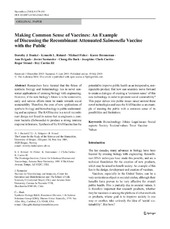Making common sense of vaccines: an example of discussing the recombinant attenuated salmonella vaccine with the public
Dankel, Dorothy Jane; Roland, Kenneth L.; Fisher, Michael; Brenneman, Karen; Delgado Alemán, Ana; Santander, Javier; Baek, Chang-Ho; Clark-Curtiss, Josephine; Strand, Roger; Curtiss, Roy III
Journal article, Peer reviewed
Published version
Date
2014-07-10Metadata
Show full item recordCollections
Original version
https://doi.org/10.1007/s11569-014-0198-6Abstract
Researchers have iterated that the future of synthetic biology and biotechnology lies in novel consumer applications of crossing biology with engineering. However, if the new biology’s future is to be sustainable, early and serious efforts must be made towards social sustainability. Therefore, the crux of new applications of synthetic biology and biotechnology is public understanding and acceptance. The RASVaccine is a novel recombinant design not found in nature that re-engineers a common bacteria (Salmonella) to produce a strong immune response in humans. Synthesis of the RASVaccine has the potential to improve public health as an inexpensive, non-injectable product. But how can scientists move forward to create a dialogue of creating a ‘common sense’ of this new technology in order to promote social sustainability? This paper delves into public issues raised around these novel technologies and uses the RASVaccine as an example of meeting the public with a common sense of its possibilities and limitations.

